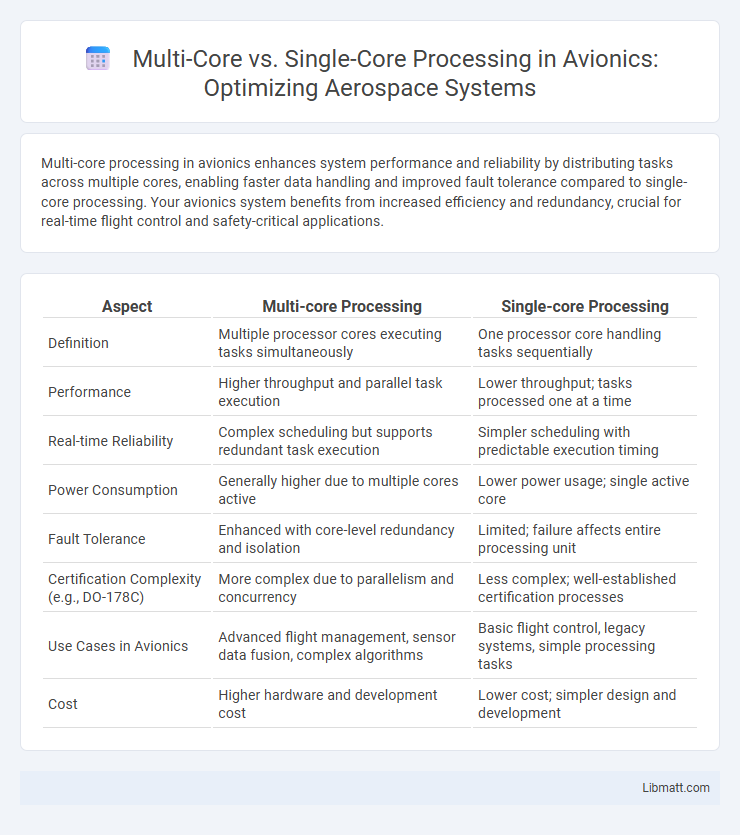Multi-core processing in avionics enhances system performance and reliability by distributing tasks across multiple cores, enabling faster data handling and improved fault tolerance compared to single-core processing. Your avionics system benefits from increased efficiency and redundancy, crucial for real-time flight control and safety-critical applications.
Table of Comparison
| Aspect | Multi-core Processing | Single-core Processing |
|---|---|---|
| Definition | Multiple processor cores executing tasks simultaneously | One processor core handling tasks sequentially |
| Performance | Higher throughput and parallel task execution | Lower throughput; tasks processed one at a time |
| Real-time Reliability | Complex scheduling but supports redundant task execution | Simpler scheduling with predictable execution timing |
| Power Consumption | Generally higher due to multiple cores active | Lower power usage; single active core |
| Fault Tolerance | Enhanced with core-level redundancy and isolation | Limited; failure affects entire processing unit |
| Certification Complexity (e.g., DO-178C) | More complex due to parallelism and concurrency | Less complex; well-established certification processes |
| Use Cases in Avionics | Advanced flight management, sensor data fusion, complex algorithms | Basic flight control, legacy systems, simple processing tasks |
| Cost | Higher hardware and development cost | Lower cost; simpler design and development |
Introduction to Processing Architectures in Avionics
Multi-core processing in avionics integrates multiple processing units on a single chip, enhancing computational efficiency and redundancy compared to single-core architectures, which rely on a solitary processing unit. This advancement supports complex real-time data handling essential for modern avionics systems, improving fault tolerance and parallelism in safety-critical applications. Single-core processors, while simpler, often face limitations in scalability and performance under demanding avionics workloads, making multi-core designs increasingly vital for next-generation flight control and navigation systems.
Fundamentals of Single-core Processing
Single-core processing in avionics relies on a single central processing unit (CPU) to execute all tasks sequentially, making it simpler but potentially slower in handling complex or simultaneous operations. This approach limits concurrency, as the CPU cannot process multiple instructions at the same time, which can impact real-time system responsiveness in safety-critical environments. Understanding the fundamentals of single-core processing helps you evaluate its suitability for specific avionics applications where deterministic behavior and certification simplicity are priorities.
Overview of Multi-core Processing
Multi-core processing in avionics involves integrating multiple processing units on a single chip to enhance computational power and efficiency compared to traditional single-core systems. This architecture enables parallel execution of complex real-time tasks, improving system responsiveness and reliability critical for flight control and safety. Advancements in multi-core processors also support scalability and energy efficiency, addressing stringent avionics certification requirements and reducing system weight.
Performance Comparison: Multi-core vs Single-core
Multi-core processing in avionics delivers significantly higher performance compared to single-core systems by enabling parallel execution of complex tasks, reducing latency, and improving system reliability through task isolation. Your avionics applications benefit from enhanced real-time responsiveness and increased throughput, as multi-core architectures efficiently handle simultaneous data streams and sensor inputs. Single-core processors, while simpler, often struggle with workload bottlenecks and slower processing speeds, making multi-core solutions essential for modern avionics performance demands.
Determinism and Predictability in Avionics Systems
Multi-core processing in avionics systems offers enhanced parallelism but can introduce challenges in determinism and predictability due to shared resources and inter-core communication, which may affect timing analysis. Single-core processing provides more straightforward timing and predictable execution, crucial for safety-critical avionics applications where precise timing guarantees are mandatory. Your choice between multi-core and single-core architectures depends on balancing computational performance with the stringent determinism requirements inherent in avionic safety standards.
Safety and Certification Challenges
Multi-core processing in avionics introduces significant safety and certification challenges due to the complexity of managing concurrent execution and mitigating interference between cores. Single-core processing simplifies certification by offering deterministic behavior and easier fault isolation, but it limits performance scalability necessary for modern avionics systems. Certification authorities like RTCA DO-178C and DO-297 require rigorous verification processes for multi-core systems to ensure compliance with safety standards in aerospace applications.
Power Consumption and Thermal Management
Multi-core processing in avionics significantly reduces power consumption by enabling parallel task execution, which increases efficiency compared to single-core processors that run tasks sequentially and often consume more energy for complex computations. Thermal management is enhanced in multi-core systems as heat generation is distributed across multiple cores, lowering the risk of overheating and improving overall system reliability, whereas single-core processors concentrate heat in one area, necessitating more intensive cooling solutions. Your avionics system benefits from lower operational costs and improved performance longevity by adopting multi-core processing architectures focused on optimized power and thermal handling.
Scalability and Future-Proofing Avionics Platforms
Multi-core processing in avionics offers superior scalability by enabling parallel task execution, which enhances system performance and fault tolerance compared to single-core processing. This architecture supports future-proofing by accommodating increasing computational demands and integrating advanced avionics applications such as real-time data analytics and AI-based flight control. The flexibility of multi-core platforms ensures compliance with evolving safety standards like DO-178C and facilitates easier hardware upgrades without complete system redesign.
Integration with Legacy Systems
Multi-core processing enhances avionics by offering greater computational power while still supporting integration with legacy single-core systems through specialized middleware and virtualization techniques. You can maintain existing avionics architectures without complete redesigns, facilitating incremental upgrades and preserving critical system certifications. This approach reduces development time and cost while enabling improved performance and reliability in aerospace applications.
Trends and Future Directions in Avionics Processing
Multi-core processing in avionics is rapidly advancing, offering significant improvements in computational power, energy efficiency, and real-time data handling compared to traditional single-core processors. The trend toward integrating heterogeneous multi-core systems enables avionics platforms to handle complex tasks such as sensor fusion, autonomous navigation, and advanced flight control more reliably. Future directions emphasize leveraging artificial intelligence acceleration, fault-tolerant architectures, and secure multi-core frameworks to enhance safety and performance in next-generation aircraft avionics systems.
Multi-core Processing vs Single-core Processing (avionics) Infographic

 libmatt.com
libmatt.com